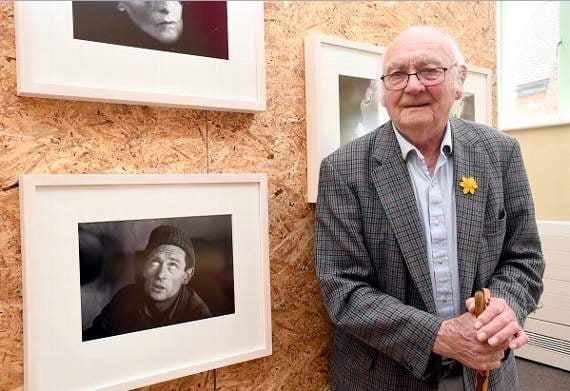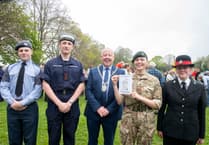LISTENING to a discussion of a landmark book based on the work of Wye Valley GP, academic Jason Griffiths noticed one glaring omission – the people whose stories were documented in it.
The book, A Fortunate Man, chronicled the lives of St Briavels GP John Eskell and his patients and became required reading for doctors working in rural areas.
It was a collaboration between writer John Berger and Swiss photo-journalist Jean Mohr, who spent time in the area in the mid-sixties.
Last weekend, 20 of the photos that appeared in the book were exhibited in St Briavels for the first time – alongside a new generation of pictures by University of Gloucestershire students showing everyday life in the Forest today.
The archive pictures are kept at the Musée de Lycée in Lausanne, Switzerland.
Among those at the opening of the exhibition at the Assembly Rooms on Saturday were some of the subjects of Mohr’s evocative pictures and Dr Eskell’s son, Simon.
The book, which is still in print today, was published in 1967 with few clues as to the setting with Dr Eskell renamed Sassell, none of his patients named and there were only references to a ‘forest’.
It was controversial for its depiction of the Forest as isolated and poorly educated – in contrast to the reality of the place.
Then there was the News of the World ‘exposé’ which revealed St Briavels as the location and painted it as some sort of British Peyton Place, a racy American soap.
It has been argued that Berger wanted to create an ‘everyman’ narrative rather than something that was rooted in a particular time and place.
The exhibition, organised by the Reading the Forest project, which is part of the Heritage Lottery-funded Foresters’ Forest programme, was in part an attempt to put the people centre stage.
The idea for looking deeper into the book came when Mr Griffiths, who works at the University of Gloucestershire, attended a conference on the work of John Berger, who was one of the country’s leading critics and who also won the Booker Prize for fiction.
Dr Griffiths said: “There were lots of doctors talking about the book and I noticed that there was very little thought about the people beyond Dr Sassell, as he is named in the book.
“This is when we got the idea because there was a bit missing to the story.
“In all the critical acclaim for the book, what is missing is the people of St Briavels and the wider area.
“What we set out to do was to fill that blank bit of the puzzle and to say there is more to this book than has been talked about.
“There are the real people in the photographs and the stories behind Mohr’s and Berger’s presentation.”
He was referring to the stories and pictures of people such as Ivy Gunter and Brychan Grettan who were at the exhibition on Saturday.
Now in their 90s, they both recalled a ‘wonderful’ GP and the unobtrusive duo recording his work in words and pictures.
Former Monmouth district councillor Mr Grettan, who farmed near Trellech, said: “Dr Eskell came to the farm and introduced these two gentlemen who wanted to meet a Welsh farmer.
“We were very friendly with Dr Eskell, that’s how it came about.
“We had an old boy, an ex-miner from the Valleys whose chest was bad.
“He was ill one night so we rang Dr Eskell and he was out there in no time, he still had his pyjamas on under his coat – and he came back the following day.”
Mohr produced an intense black and white character study which threw some of Mr Grettan’s friends who thought it was one of the men from the “Polish camp” at St Briavels.
Ivy Gunter, who lives in the village, said she owed her life to Dr Eskell after he insisted a hospital bed be found for her when she contracted sepsis.
She said: “I got bitten by a couple of horse flies – what I call old maids. I had sepsis and if it wasn’t for Dr Eskell, I wouldn’t be here now.”
While much of the focus on A Fortunate Man over the years has been on Berger’s text, the project sought to reclaim the importance of the photographs as an integral part of the book.
Mr Griffiths said: “Too often the photographs have been forgotten or seen as a secondary part of the book.
“This process of bringing over the photographs and taking them more seriously has got us to reappraise the book.
“When you focus on the text, it has one side of the story but when you take the photographs seriously as an integral part of the story they bring it alive in a different way.”
The exhibition was opened by former Lord Lieutenant of Gloucestershire Dame Janet Trotter who said reading the book had highlighted something that to some extent has been lost over the last 50 years.
She contrasted Dr Eskell’s role as the village doctor knowing his patients at a deep level with the treatment a terminally-ill friend is receiving, where there is no continuity of care.
She said: “I rather like the notion of a doctor in the village tending and caring for patients and knowing his patients.
“It might be romantic, but what struck me about Dr Eskell is that he managed to know them, to understand them and from that he got a sense of what therapy might be best and that wasn’t always high medicine.
“I think the sense that we’ve lost some of that in the way we manage our public services is something that came home to me in particular.”
She praised the project as one of those which help the Forest to live.
She added: “Every time I come to the Forest I get that sense of community and it is projects like this that make the Forest and its heart live.”
-------
Revisiting the Forest
HOSTING the exhibition – which first showed at the University of Gloucestershire’s Hardwick Gallery in Cheltenham – also gave an interesting opportunity to invite students to be inspired by Mohr’s work.
Four students spent time with four organisations in the Dean with the aim of showcasing the diversity of life in the Forest.
Giles W Bennett shadowed the street teams of the Forest of Dean District Council, setting their work in a broader narrative about the geography of the Forest’s landscape.
Jasmine Dalmeny took the opportunity offered by a placement with the Wyedean Housing Association to show the variety of social housing, aiming to convey them as viable and interesting places to live.
Noemi Filetti photographed students and classes at Five Acres School in Berry Hill, capturing the personalities of the young people and staff there.
Victor Storublev explored the streets and buildings of Cinderford with the Forest Voluntary Action Forum and captured the diversity of them and the people of the town.
The results of the project shot in a short time and with input of their hosts celebrate life in the Forest today.





Comments
This article has no comments yet. Be the first to leave a comment.